The best B2B commercial teams drive simplicity into the way their teams sell complex solutions. Yet no matter how  streamlined your team’s approach to selling, B2B buying processes are rarely straightforward or transparent to the sales teams navigating them. As a buying process moves toward its conclusion, the uncertainties faced by your sales team are often amplified, sometimes as part of a deliberate buyer strategy.
streamlined your team’s approach to selling, B2B buying processes are rarely straightforward or transparent to the sales teams navigating them. As a buying process moves toward its conclusion, the uncertainties faced by your sales team are often amplified, sometimes as part of a deliberate buyer strategy.
Sales Challenges. Early in the sales cycle, the unknowns confronting sales generally result from the challenges of connecting and engaging with buyers. Buyers start with a digital information advantage. But buyers also erect walls as they juggle competing priorities, making it difficult for a lonely sales rep to overcome buyer inertia. The biggest sales challenge early in the cycle is to combat the status quo and get a qualified buyer to evaluate your solution with the active involvement of your broader sales team.
In the middle of the sales cycle, your sales rep breathes a sigh of relief as the buyer pivots to active evaluation. A commitment by real buyers to allocate time and bandwidth to Evaluate your solution is a breakthrough that justifies the investment of additional sales resources and the involvement of sales specialists. It is time to introduce your solution consultants, subject matter experts, technical sales or other presales professionals for in-depth engagement with the buyer team.
Later in the Sales Cycle. As buyer evaluation approaches completion, a shroud of mystery often descends on the 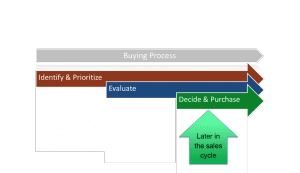 sales team. Sometimes the uncertainty is buyer politics. Has your sales team satisfied the most difficult customer stakeholders? Which stakeholder will be your champion? Who really makes the decision on whether to move forward with a purchase? Is there a genuine consensus to buy?
sales team. Sometimes the uncertainty is buyer politics. Has your sales team satisfied the most difficult customer stakeholders? Which stakeholder will be your champion? Who really makes the decision on whether to move forward with a purchase? Is there a genuine consensus to buy?
Often enough, however, the uncertainties relate to the buying process itself. Do they have budget? Who is going to pay for it? Who in senior management has to approve? Finance gets involved. IT may have to approve. Legal reviews contracts. Procurement often takes over, deploying a playbook that their own colleagues don’t understand or won’t acknowledge.
Richardson’s 2018 survey, Understanding Sales Challenges, highlighted the top 3 concerns among sales executives: 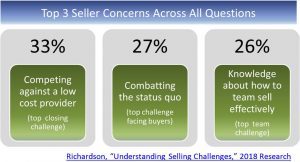 (1) Competing against a low cost provider, (2) Combatting the status quo and (3) Knowledge about how to team sell effectively. Later in the sales cycle, the role of team selling (the third concern) diminishes even if the interest of presales professionals, introduced in the evaluation stage, intensifies. This puts the pressure back on the sales rep or account manager. The broader team looks to the rep to resolve the uncertainties of whether you have effectively overcome the status quo (the second concern) and whether the buyer has really understood your solution’s differentiation versus the competition (the first concern). A clear picture almost never emerges, setting the stage for weak-kneed negotiation and price concessions.
(1) Competing against a low cost provider, (2) Combatting the status quo and (3) Knowledge about how to team sell effectively. Later in the sales cycle, the role of team selling (the third concern) diminishes even if the interest of presales professionals, introduced in the evaluation stage, intensifies. This puts the pressure back on the sales rep or account manager. The broader team looks to the rep to resolve the uncertainties of whether you have effectively overcome the status quo (the second concern) and whether the buyer has really understood your solution’s differentiation versus the competition (the first concern). A clear picture almost never emerges, setting the stage for weak-kneed negotiation and price concessions.
Objectives Later in the Sales Cycle. Facing uncertainty at the end of the sales cycle, there are three sales objectives as buying teams Decide & Purchase your solution:
- Drive the Time to Close. You have supported an evaluation process, but “Time Kills All Deals.” Overcome decision procrastination by sponsors and stakeholders. Crystallize buyer team expectations about what your solution will deliver to them and when. Demonstrate and reinforce the point that buying your solution will have a significant business impact. Create urgency.
- Connect with the Purchasing Process. Buyers turn inward to make decisions. Radio silence descends on the sales team. A sales account executive needs substantive ways to stay involved. Respond rapidly to requests. More importantly, stay engaged in your sponsor’s internal business case to buy. Your team won’t be represented at buyer meetings. Seed the content for those meetings. Bolster your sponsor’s backbone.
- Leverage Value in Negotiations. Whether or not procurement professionals acknowledge that value matters to them, value matters to the buyer organization and to your sponsor. Handle a straight-up price negotiation by redirecting the discussion toward value and business impact. Value is a lever to help your sales team understand your competitive position. Value helps to generate win/win proposals and give-get counter-offers. Your team’s confidence in the value of your solution supports confidence in negotiation.
- Value Propositions Support Closing More Deals at Higher Prices. A Value Proposition is a central piece of content that supports the best B2B sales teams. At its foundation, a Value Proposition addresses the most important
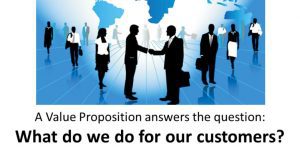 question for a buyer: “what do you do for your customers?” A good Value Proposition is both simpler than, and more persuasive than, a spreadsheet. Good Value Propositions are designed with flexibility in how your sales teams have conversations. Sales needs to be able to articulate your Value Proposition in qualitative, quantitative and financial terms, but also to go only as far as any specific customer conversation requires.
question for a buyer: “what do you do for your customers?” A good Value Proposition is both simpler than, and more persuasive than, a spreadsheet. Good Value Propositions are designed with flexibility in how your sales teams have conversations. Sales needs to be able to articulate your Value Proposition in qualitative, quantitative and financial terms, but also to go only as far as any specific customer conversation requires.
When to Use Value. There is a widely-held view that Value Propositions, ROI Calculators and TCO analyses should be held in reserve as a negotiation tool. Treating Value Propositions as a reactive asset for sales to respond to procurement misses the point. Value Propositions may have an occasional benefit when launched into the closing stage, but they provide a more powerful lever for sales when value discussions are initiated early. Value Propositions can be introduced naturally into customer conversations, as Flexible Case Studies, where they become an effective means to present your solution from a customer-centric perspective. Good case studies highlight what you do for your customers, how you do it, how much better you are and what that is worth to the customer.
Introducing your Value Proposition early gives your team an edge. Buyer surveys show that the first seller to turn a  vision into a clear path to value wins the business 74% of the time. SiriusDecisions’ research indicates that the number one problem for sales effectiveness is an inability for sales teams to convey their Value Proposition.
vision into a clear path to value wins the business 74% of the time. SiriusDecisions’ research indicates that the number one problem for sales effectiveness is an inability for sales teams to convey their Value Proposition.
Flexible Case Studies allow your sales team to introduce value early, changing assumptions as they learn more about buyer specifics. The resulting transition of the case study to a specific Customer Value Analysis then becomes an  integral part of the buyer evaluation, setting up the opportunity to get buy-in from customer stakeholders as they decide whether they are individually onboard. A Customer Value Analysis makes a transition to a Shared Business Case to buy as stakeholder consensus emerges and as a customer sponsor takes ownership of the process and decision to purchase. An agreement between sales and the customer sponsor in the form of a Shared Business Case supports faster and better results during the negotiation and closing stages of the sales cycle.
integral part of the buyer evaluation, setting up the opportunity to get buy-in from customer stakeholders as they decide whether they are individually onboard. A Customer Value Analysis makes a transition to a Shared Business Case to buy as stakeholder consensus emerges and as a customer sponsor takes ownership of the process and decision to purchase. An agreement between sales and the customer sponsor in the form of a Shared Business Case supports faster and better results during the negotiation and closing stages of the sales cycle.
How Sales Teams Use Value Propositions Later in the Sales Cycle. Let’s look at how sales teams use Value Propositions to achieve their three primary objectives in the closing phases of the sales cycle.
- Drive the Time to Close.Time is always precious for B2B sales, but time seems to pass faster while your team is in the middle of an evaluation process. The activity involved in driving an evaluation program, responding to questions and addressing concerns creates a sense of progress. That sense of progress decelerates or comes to a halt as an evaluation winds down. Good sales reps sense that they are in the danger zone, recognizing the lesson they have learned from experience, “Time Kills All Deals.”
- A Value Proposition becomes an Endpoint for Evaluation. Whenever your team’s Value Analysis evolves into a
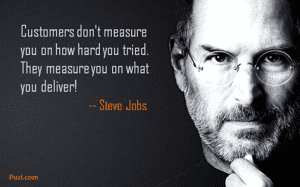 Shared Business Case to Buy, co-owned by a buyer sponsor, the rational part of the evaluation should be complete. Buyer stakeholders have had the opportunity to validate or correct specific assumptions, provide feedback on any customization and challenge the sales team’s assertions and claims. Your team has demonstrated that you will deliver value. The reasons to procrastinate are limited. Crystallizing a Business Cases to Buy supports a sponsor in building consensus among buyer stakeholders. It provides a rational foundation for a buyer committee and a buyer sponsor to make the decision to buy.
Shared Business Case to Buy, co-owned by a buyer sponsor, the rational part of the evaluation should be complete. Buyer stakeholders have had the opportunity to validate or correct specific assumptions, provide feedback on any customization and challenge the sales team’s assertions and claims. Your team has demonstrated that you will deliver value. The reasons to procrastinate are limited. Crystallizing a Business Cases to Buy supports a sponsor in building consensus among buyer stakeholders. It provides a rational foundation for a buyer committee and a buyer sponsor to make the decision to buy. - A Value Proposition Sets Expectations. A Shared Business Case to Buy demonstrates that buying your solution will have a significant business impact. That impact and the team’s corresponding accountability to deliver
 results creates urgency. Faster time to value means greater cumulative value. Working through the timing of those results as part of a Value Proposition can help to set expectations both for your sales team and for the buyer sponsor, including implementation timing and the timing of results. Concrete timetables at this stage, as expectations are formed, help sponsors to drive urgency in their organization’s buying process.
results creates urgency. Faster time to value means greater cumulative value. Working through the timing of those results as part of a Value Proposition can help to set expectations both for your sales team and for the buyer sponsor, including implementation timing and the timing of results. Concrete timetables at this stage, as expectations are formed, help sponsors to drive urgency in their organization’s buying process. - A Value Proposition is a Basis for Alignment. When sellers and buyers agree on a Business Case to Buy, they acknowledge their alignment. The buyer sponsor supports and trusts your sales team. Your team signs up to
 deliver results to the buyer. Buyer and seller jointly own the outcome of a solution’s implementation. When your team commits to outcomes, the buyer sponsor is motivated to drive a purchasing process toward a conclusion.
deliver results to the buyer. Buyer and seller jointly own the outcome of a solution’s implementation. When your team commits to outcomes, the buyer sponsor is motivated to drive a purchasing process toward a conclusion.
- A Value Proposition becomes an Endpoint for Evaluation. Whenever your team’s Value Analysis evolves into a
- Connect with the Purchasing Process.
Establishing a consensus Business Case to Buy with a buyer sponsor before a sponsor turns a deal over to
 procurement provides a substantial advantage. Buyers naturally turn inward during the Decide & Purchase phase. Your sales team shouldn’t expect an invitation to buyer meetings. The silence can be deafening. Your team loses confidence. They think they made a mistake in the sales process, lose patience and dream up concessions that could stimulate active buyer reengagement.
procurement provides a substantial advantage. Buyers naturally turn inward during the Decide & Purchase phase. Your sales team shouldn’t expect an invitation to buyer meetings. The silence can be deafening. Your team loses confidence. They think they made a mistake in the sales process, lose patience and dream up concessions that could stimulate active buyer reengagement.
A sales executive needs substantive ways to stay involved with buyers as they Decide & Purchase. Set the stage to stay connected.
- Respond rapidly. Procurement professionals know how to throw curve balls to sales teams. Frozen in the headlights, teams get bogged down, trying to craft the optimal response. Resist the temptation to overthink. Answers to questions don’t need to be perfect or exhaustive. Fast responses support engagement and urgency in buying.
- Stay engaged in your sponsor’s Business Case to Buy. There is no better way to have a window into a buyer’s purchasing and procurement process than to provide content that a sponsor can use internally. A Shared
 Business Case to Buy is a natural way to sustain co-dependence between buyer and seller. Providing the Business Case helps a sales rep to keep a seat at the table as your sponsor prepares internal documents and plans internal meetings. Modifying the Business Case is a reason to stay in touch, to make ongoing suggestions and to understand the evolving purchasing process.
Business Case to Buy is a natural way to sustain co-dependence between buyer and seller. Providing the Business Case helps a sales rep to keep a seat at the table as your sponsor prepares internal documents and plans internal meetings. Modifying the Business Case is a reason to stay in touch, to make ongoing suggestions and to understand the evolving purchasing process. - Sustain your sponsor’s confidence. Purchasing processes are often convoluted, testing a sponsor’s conviction that the purchase is necessary. As champions of your solution confront internal challenges, the personal risk of sponsorship rises and convictions implanted during a persuasive evaluation fade as time passes. Buyer sponsors sometimes lose their nerve. Embedding powerful countermeasures with your sponsor anticipate the problem. A strong Value Proposition bolsters a sponsor’s backbone as they face and surmount internal hurdles.
- Leverage Value in Negotiations.
Sales teams establishing buyer agreement on value, are less likely to face a price negotiation. Value discussions change the tenor of the buyer-seller interaction.
 That said, many organizations set up a deliberate process to put sales in direct contact with procurement. Procurement professionals are paid to negotiate. They have a playbook. Whether or not procurement acknowledges that value matters to them, value matters to the buyer organization and to your sponsor.
That said, many organizations set up a deliberate process to put sales in direct contact with procurement. Procurement professionals are paid to negotiate. They have a playbook. Whether or not procurement acknowledges that value matters to them, value matters to the buyer organization and to your sponsor.
Established value provides leverage, whether in a direct negotiation with your sponsor or in addressing procurement’s playbook.
- Redirect price discussions toward value. Buyers open with several approaches to reducing price: competing
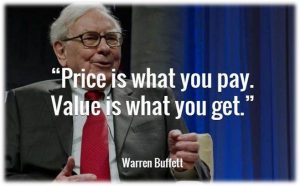 priorities, available funds and direct competitors. Sales teams need answers. With a strongly positioned solution, a sales team can sometimes draw a firm line on pricing based on your policies, your standards or your process. One fallback approach is to attempt a round of poker based on the competitor’s price. Before caving in with price concessions, some underequipped sales reps grovel based on their own costs.
priorities, available funds and direct competitors. Sales teams need answers. With a strongly positioned solution, a sales team can sometimes draw a firm line on pricing based on your policies, your standards or your process. One fallback approach is to attempt a round of poker based on the competitor’s price. Before caving in with price concessions, some underequipped sales reps grovel based on their own costs.
The best answer to a price opening is a value response. Warren Buffett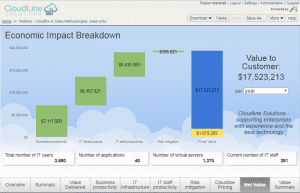 highlighted the ying and the yang of negotiation. “Price is what you pay. Value is what you get.” When a buyer raises price, respond with value. Highlighting value refocuses on your differentiation and emphasizes the bottom-line net benefit or ROI of purchasing your premium priced product. Focusing on value also positions your team to counter price reduction proposals with value-reducing alternatives. “If you pay less you get less.”
highlighted the ying and the yang of negotiation. “Price is what you pay. Value is what you get.” When a buyer raises price, respond with value. Highlighting value refocuses on your differentiation and emphasizes the bottom-line net benefit or ROI of purchasing your premium priced product. Focusing on value also positions your team to counter price reduction proposals with value-reducing alternatives. “If you pay less you get less.” - Discover where you stand. Value claims always have a reference point, whether the status quo, a generalized
 competitor or a specific competitor. Even if your team’s value discussions have not focused on a specific competitive reference point earlier in the sales cycle, the value conversation in a negotiation can help draw more information about who your real competition is late in the cycle. Buyers making a rational challenge to a value assertion are often tempted into getting specific. As they do so, they provide direct information or hints about the most important alternative they are considering. A Value Proposition provides a lever that helps your sales team understand your competitive position.
competitor or a specific competitor. Even if your team’s value discussions have not focused on a specific competitive reference point earlier in the sales cycle, the value conversation in a negotiation can help draw more information about who your real competition is late in the cycle. Buyers making a rational challenge to a value assertion are often tempted into getting specific. As they do so, they provide direct information or hints about the most important alternative they are considering. A Value Proposition provides a lever that helps your sales team understand your competitive position. - Use value to structure proposals and counters. Good strategic pricing sets
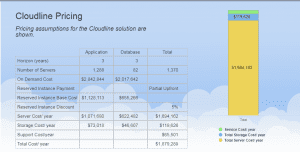 initial offering prices based on quantitative value to the customer. Sales teams should have confidence that their published prices and initial proposals are win-win.
initial offering prices based on quantitative value to the customer. Sales teams should have confidence that their published prices and initial proposals are win-win.
But value-based pricing for many offerings can go beyond posted prices to specific transactional price adjustments based on value. - Design give-gets.
 Customizing a lower priced offering based on value helps to maintain profitability while improving the fit of the offering to buyer specifics. It can help to stake out negotiating lines by making it clear that a price reduction involves a value reduction resulting from a different offering. Value helps to move the negotiation process forward more profitably than making simple price concessions.
Customizing a lower priced offering based on value helps to maintain profitability while improving the fit of the offering to buyer specifics. It can help to stake out negotiating lines by making it clear that a price reduction involves a value reduction resulting from a different offering. Value helps to move the negotiation process forward more profitably than making simple price concessions.
For many innovative offerings, it is unnecessary to go this far, but sometimes there is enough risk to the buyer that sales organizations decide to offer performance contracts based on value. These contracts, as a part of the sales playbook, offer price incentives, price concessions or rebates based on value delivered and can be built into contractual terms. This approach can drive strong market share growth, unless and until competitors respond with their own, similar deals. Sustaining profitable performance contracts requires high standards of measuring value delivered and a systematic approach to value assessment with customers on an ongoing basis. With performance contracts, as with warranties and guaranties, there is little doubt that buyer and seller are aligned, but this alignment comes with corresponding seller risk which should be priced and managed accordingly.
sales playbook, offer price incentives, price concessions or rebates based on value delivered and can be built into contractual terms. This approach can drive strong market share growth, unless and until competitors respond with their own, similar deals. Sustaining profitable performance contracts requires high standards of measuring value delivered and a systematic approach to value assessment with customers on an ongoing basis. With performance contracts, as with warranties and guaranties, there is little doubt that buyer and seller are aligned, but this alignment comes with corresponding seller risk which should be priced and managed accordingly. - Sustain your sales team’s confidence. Establishing a shared Business Case to Buy makes it harder for procurement to execute pricing tactics from their playbook. Sales teams start procurement conversations with greater confidence. Even if purchasing decides to play poker, Value Propositions provide sales teams with a stronger hand. Some poker players are better at bluffing and at reading bluffs than others. A strong hand not only raises the objective odds of winning the hand, it also improves a player’s self-assurance.
 Value Propositions provide your sales team with an edge at the table. CRM data from organizations adopting value selling show that opportunities where Value Propositions are used have 5-15% higher win rates and 5-25% higher price outcomes. Confidence in the value of your solution reduces doubt during negotiation and results in more successful outcomes.
Value Propositions provide your sales team with an edge at the table. CRM data from organizations adopting value selling show that opportunities where Value Propositions are used have 5-15% higher win rates and 5-25% higher price outcomes. Confidence in the value of your solution reduces doubt during negotiation and results in more successful outcomes.
- Redirect price discussions toward value. Buyers open with several approaches to reducing price: competing
Value Propositions as Tools. The best B2B enterprises deploy Value Propositions to improve B2B sales performance, addressing sales challenges in a way consistent with an organization’s sales training, throughout the B2B sales cycle. They are useful early in the sales cycle as Flexible Case Studies for sales to qualify opportunities and engage customer executives. In the middle of the sales cycle, Value Propositions provide Customer Value Analyses as an important consultative selling tool that address presales challenges. As customers decide to purchase, the Value Proposition becomes a Shared Business Case, collaboratively agreed between sales executives and customer sponsors, that speed the closing process as a buyer’s financial rationale to buy.
It isn’t hard to start value selling. Value Propositions provide core sales content that helps sales teams communicate what your solution does for your customers. Value Propositions are a shared basis for collaboration that help sales teams win.

